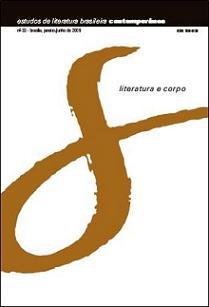Um réquiem para o Rio, outro para o Brasil:
sobre Vista do Rio, de Rodrigo Lacerda
Abstract
Em uma evocação do Rio de Janeiro, Rodrigo Lacerda expõe a metrópole em um quadro de realismo rude, quase feroz, porém matizado, muitas vezes, por um tom solidário, que se aproxima da compaixão. Marco Aurélio e Virgílio dividem a cena em diferentes momentos: no início dos anos 1980, quando são adolescentes típicos de Ipanema, e quase duas décadas mais tarde, quando se reencontram por iniciativa de um deles. Este artigo comenta a maneira como Marco Aurélio, narrador-personagem, articula passado e presente em relação a si mesmo e ao amigo, conectando suas trajetórias individuais à assustadora degradação que invade e desfigura o espaço urbano. A minuciosa construção de um condomínio fictício, o Estrela de Ipanema, mostrado em seu esplendor inicial e, depois, à beira da ruína, ganha amplitude e se torna metáfora de um Brasil que, até hoje, não superou sua condição de promessa persistente ou obra inconclusa.
Downloads
References
GALVÃO, Walnice N. As musas sob assédio: literatura e indústria cultural no Brasil. São Paulo: SENAC, 2005.
LACERDA, Rodrigo. Vista do Rio. São Paulo: Cosac Naify, 2004.
______. Tripé. São Paulo: Ateliê, 1999.
JATOBÁ, Vinícius Martinelli. “O ‘realista suave’ vê o Rio”. Disponível em URL: <http://www.paralelos.org/out03/000277.html>. Acesso em 22 jan. 2008.
SILVA, Vítor M. A. Teoria da literatura. 8ª ed. Coimbra: Livraria Almedina, 1988.
Downloads
Published
How to Cite
Issue
Section
License
Authors who publish in this journal agree to the following terms:
a) The authors maintain the copyright and grant the journal the right of first publication, the work being simultaneously licensed under the Creative Commons Attribution License-Non Commercial 4.0 which allows the sharing of the work with acknowledgment of the authorship of the work and publication this journal.
b) Authors are authorized to enter into additional contracts separately, for non-exclusive distribution of the version of the work published in this journal (eg publish in institutional repository or as a book chapter), with authorship recognition and publication in this journal.
c) Authors are allowed and encouraged to publish and distribute their work online (eg in institutional repositories or on their personal page) after the editorial process, as this can generate productive changes, as well as increase the impact and citation of published work (See The Effect of Free Access).
d) The authors of the approved works authorize the magazine to, after publication, transfer its content for reproduction in content crawlers, virtual libraries and the like.
e) The authors assume that the texts submitted to the publication are of their original creation, being fully responsible for their content in the event of possible opposition by third parties.


